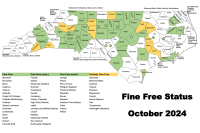Road standards would help rescue vehicles
When a roaring forest fire whipped through a mountainside development in Swain County two months ago — burning nine homes to the ground — the narrow, steep road leading to the community stymied efforts of firefighters.
“The road was barely big enough for one truck,” said Bryson City Fire Chief Joey Hughes. “We’d meet each other on the road and one would have to backup, and the switchbacks were terrible.”
Firefighters were afraid to send too many trucks up the road at once — despite support pouring in from neighboring counties — because they were afraid the trucks could block each other in, creating a dangerous situation with a fast moving and unpredictable forest fire.
Efforts now under way in Swain County could remedy safety issues posed by steep and narrow roads in the future. The Swain County planning board has spent the past two months drafting regulations for roads in mountain developments. (See “What the draft says” for specifics.)
The effort marks the first time Swain County has embarked on planning and development regulations of any kind. County commissioners appointed the first-ever planning board in February to begin tackling development issues.
Related Items
The road standards are only a draft at this time. The planning board is still mulling over the language, but expects to finish up within the next few weeks. The commissioners have final say on what gets passed, but the public will have ample opportunity to weigh in first.
There will be two informal workshops to give the public an opportunity to ask questions, make suggestions and share their concerns.
“It will give everybody an equal representation for their view point,” County Manager Kevin King said.
Both the planning board and county commissioners will be at the public workshops. Soliciting public feedback in a workshop setting will give the planning board and commissioners an opportunity to make changes to the ordinance if necessary before it proceeds to a formal public hearing. A formal public hearing will be the final step prior to the adoption of the ordinance by commissioners. The ordinance would only apply to new roads and development built from this point forward.
Hughes said from what he’s heard of the regulations so far, access for emergency vehicles will be vastly improved.
“It would help a lot,” Hughes said. “I agree 100 percent.”
Jonathan Douthit, chairman of the new planning board, said safety was the primary goal.
“We looked primarily at public safety and access for emergency services,” Douthit said.
Roads were the first things commissioners asked the planning board to address.
“In order to get to a piece of property you have to use a road, so it made sense to do that first,” said County Manager Kevin King. “The planning board could be given other things to study in the future.”
While developers may have to spend more up front to build better roads, Douthit said most will realize the cost benefit.
“A good road system is a valuable amenity to offer when you sell property,” Douthit said. Likewise, a bad road can keep lots from selling. Douthit could think of a couple of developments that fall into that category.
“You’d have to have a caterpillar tractor to get in there when it rained,” Douthit said.
The ordinance requires disclosure to the buyers — on the property deed and a sign at the development’s entrance — if roads exceed an 18 percent grade. That disclosure is a sort of “buyer beware” that emergency vehicles could face challenges reaching their home.
“People need to know that,” Douthit said. “They are used to dialing 911 and having people show up in relatively short period of time.”
In drafting the road standards, the planning board looked at development ordinances from a host of other places — from half a dozen counties in WNC to resort towns in Colorado, Wyoming and Utah.
“We were trying to look at places with the same topographical character as we have,” Douthit said. “We figured why reinvent wheels here.”
The planning board borrowed the most from Haywood and Watauga counties. As part of their homework, the planning board contacted the insurance industry and the Department of Transportation as well to find out what kinds of rules and standards they had.
If the ordinance passes, the county will be left with the question of exactly who is going to sign off on developer’s road plans and enforce the new regulations. Currently, Swain County does not have a planning department or county planner. As of now, money has not been allocated in the 2007-08 budget for such a position.
What the draft says
Here are key points from an ordinance being
considered by the Swain County planning board to regulate roads in mountain developments.
• Roads are capped at a 20 percent grade, with an exception of up to 25 percent in “extreme cases.” To qualify for the exception, a certified professional engineer must sign off on the road design and stability and testify that there “are no reasonable alternative routes.”
• Roads exceeding a 15 percent grade must be paved for that section as well as 300???? feet on either side.
• Switchbacks grades can’t exceed 10 percent.
• For developments with roads exceeding 18 percent, a disclosure statement must be included on the final plat stating, “Access to homes using such roads may be limited and emergency vehicles and public utility access to homes within using such roads within the subdivision may be limited.” A sign with a same statement must be permanently posted at the entrance to the subdivision as well.
• Roads leading to 12 or more lots must be 18 feet wide. Roads leading to six to 12 lots must be 16 feet wide. Roads leading to less than six lots must be 12 feet wide.
• Curves must have centerline turning radius of 35 feet.
• Dead-end roads must have turnaround capabilities.









